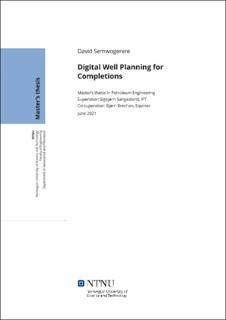| dc.contributor.advisor | Sigbjørn, Sangesland | |
| dc.contributor.advisor | Bjørn, Brechan | |
| dc.contributor.author | David, Semwogerere | |
| dc.date.accessioned | 2021-09-24T18:09:56Z | |
| dc.date.available | 2021-09-24T18:09:56Z | |
| dc.date.issued | 2021 | |
| dc.identifier | no.ntnu:inspera:85047365:47159143 | |
| dc.identifier.uri | https://hdl.handle.net/11250/2781640 | |
| dc.description.abstract | Den nåværende planleggingsprosessen for brønnkomplettering er i de fleste operatørselskaper en manuell prosess som involverer praktisk tilnærming trinn for trinn. Det er preget av gjentatte beregninger, møter og utveksling av e-post for reservoar og undergrunnsinformasjon og mye papirarbeid. Denne oppgaven introduserer en automatisert designprosess for brønnkomplettering basert på digitalisering av de manuelle elementene som inngår i den tradisjonelle planleggingen av en brønnkomplettering.
Planlegging av brønnkomplettering har to trinn. Den første fasen er basis av design (Basis of Design- BOD) hvor metoder og teknologi velges basert på brønnen kravspesifikasjon (Statement of Requirements- SOR). Den andre fasen er operasjonsplanlegging for distribusjon av teknologien valgt i BOD. Disse prosessene tar lang tid i dagens brønnplanleggingsmetodikk og i lys av nåværende industriutfordringer (covid, fornybar energi, fallende oljepris). Enhver forbedring i effektivitet og raskere brønnleveranse kan bidra til vesentlige kostnadsreduksjoner. Dette kan oppnås med digital brønnplanlegging.
For å illustrere hvordan dette fungerer ble det skrevet et program i Python som automatisk velger en sandkontrollstrategi på BOD planleggingsnivå. Programmet mottar utvalgte data og formasjonsspenninger som inndata fra undergrunnen, og vurderer deretter produksjonskrav fra produksjonsteamet og anbefaler deretter en strategi for sandkontroll.
Som et eksempel, beskriver oppgaven videre en arbeidsflyt for planlegging og operasjon for plassering av en brønnkomplettering for sandkontroll. Dette er en vanlig operasjonssekvens basert på standarder og erfaring med relatert utstyr og konstruksjon for vellykket gjennomføring av slike operasjoner.
Utfordringen, og en mulighet for fremtidig arbeid, er hvordan man kan slå sammen den digitale brønnplanleggingen med automatiseringsutførelsen på riggen / plattformen / workover-enhetene for å tillate robotikk å lese instruksjoner og utføre / arrangere ferdigstillelse etter behov. | |
| dc.description.abstract | The current well completion planning process in most operating companies is a manual process involving hands-on approach from one step to another. It is typified by repetitive calculations, meetings and email exchanges for reservoir and subsurface input and a lot of paperwork. This thesis introduces an automated well completion design process based on digitalization of the manual elements of the traditional well completion planning.
Well completion planning has 2 stages. The first stage is the Basis of Design (BOD) stage where methods and technology are selected based on the well Statement of Requirements (SOR). The second stage is operations planning for deployment of the technology selected in the BOD. These processes take a long time in the current well planning methodology and in light current industry challenges (covid, renewables, falling oil prices), any improvement in efficiency and faster well delivery can go a long way in cost reduction. This can be achieved with digital well planning.
To illustrate how this works, a program was written in Python that automatically selects a sand control strategy at the BOD planning level. The program receives sieve analysis and formation stresses as input data from subsurface, it then considers production requirements from the production team and recommends a sand control strategy.
The thesis further describes a workflow for operations planning in well completion deployment using sand control deployment as an example. This relies on the common sequence of operations based on standards and experience with related equipment and engineering for successful execution of these operations.
The challenge however, and an opportunity for future work, is how to merge the digital well planning with automation execution on the rig/platform/workover units to allow robotics to read instructions and execute/deploy the completion as required. | |
| dc.language | eng | |
| dc.publisher | NTNU | |
| dc.title | Digital Well Planning for Completions | |
| dc.type | Master thesis | |
